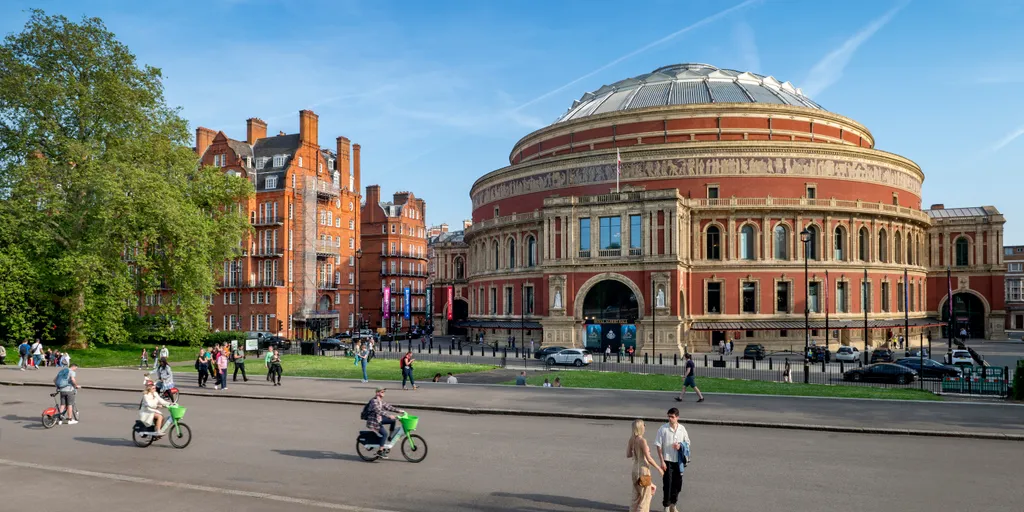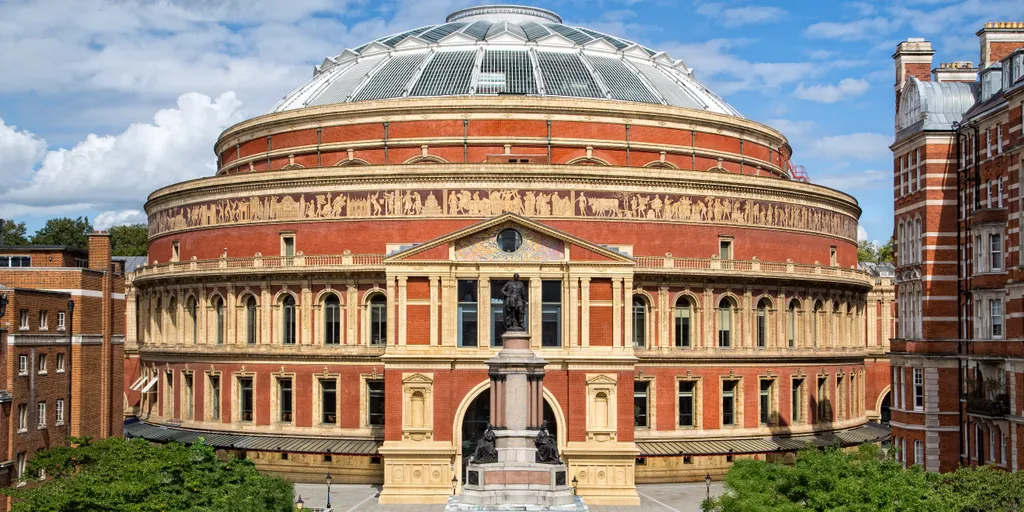The Royal Albert Hall, located in South Kensington, London, is one of the world’s most celebrated concert halls. Known for its distinctive circular design, outstanding acoustics, and rich history, the hall has become a symbol of Britain’s commitment to the arts and a venue of international prestige. Since its opening in 1871, the Royal Albert Hall has hosted a dazzling array of events, ranging from classical concerts and ballets to rock music, sporting events, political gatherings, and charity galas.
With its motto inscribed around the exterior—“THINE O LORD IS THE GREATNESS AND THE POWER AND THE GLORY AND THE VICTORY AND THE MAJESTY”—the hall embodies grandeur, cultural pride, and accessibility. Today, it stands not only as a monument to Victorian ambition but also as a living, thriving institution at the heart of London’s cultural life.

Origins and Conception
The Royal Albert Hall was conceived as part of Prince Albert’s vision for South Kensington, an area that became known as “Albertopolis”. After the Great Exhibition of 1851, which Albert had championed, he envisioned creating a cultural district that would combine education, science, and the arts. The proceeds from the exhibition were used to fund museums, colleges, and institutions, including the Victoria and Albert Museum, the Natural History Museum, and the Science Museum.
Prince Albert imagined a permanent hall of art and science that would inspire and educate the public. Unfortunately, he died in 1861 before his dream was realized. His widow, Queen Victoria, ensured that the project continued in his memory. The hall was named the Royal Albert Hall of Arts and Sciences in his honour, cementing his legacy as a patron of culture and knowledge.
Architecture and Design
The hall was designed by Captain Francis Fowke and Major-General Henry Y.D. Scott of the Royal Engineers. The design drew inspiration from ancient amphitheatres in Rome and Greece, resulting in its iconic elliptical shape. The foundation stone was laid by Queen Victoria in 1867, and the building officially opened on 29 March 1871 with a grand ceremony attended by the Queen herself.
Key Features:
- Exterior: The building is constructed in striking red brick and terracotta, with a frieze encircling the hall that depicts allegorical scenes of the arts and sciences. The entire structure is crowned with a massive wrought-iron and glass dome, which was, at the time, one of the largest of its kind.
- The Dome: Initially, the dome caused problems with acoustics, creating an echo that made performances challenging. This was later addressed by the addition of fibreglass acoustic diffusers, affectionately nicknamed “mushrooms,” suspended from the ceiling in the 1960s.
- Capacity: The Royal Albert Hall can seat around 5,200 people, making it one of the largest concert venues in Britain. Its seating includes grand tier boxes, stalls, arena floor seating, and the famous gallery at the top.
- Organ: The hall houses the “Voice of Jupiter”, one of the world’s largest pipe organs. Installed by Henry Willis & Sons, it has over 9,900 pipes and has been a centrepiece of the hall since its opening.
The architecture of the Royal Albert Hall represents Victorian grandeur, blending functionality with artistic ambition, and it remains one of London’s most recognisable landmarks.
Early Years and Opening Ceremony
When the hall opened in 1871, Queen Victoria was reportedly so overcome with emotion that she could barely speak. The first concert featured Handel’s Messiah, a fitting choice for a venue that aspired to celebrate high culture and elevate public taste.
In its early years, the hall hosted classical concerts, scientific lectures, exhibitions, and public meetings. It quickly became a symbol of Victorian society’s aspirations, blending entertainment with education. However, the hall also faced criticism for its acoustics, which made some early performances less successful than hoped. Despite these challenges, it established itself as a premier cultural venue.
The Proms and Classical Music
Perhaps the most famous association of the Royal Albert Hall is with the BBC Proms, a series of summer concerts that began in 1895 under conductor Henry Wood. The Proms were intended to make classical music accessible to a wider audience by offering affordable tickets and an informal atmosphere.
Today, the BBC Proms remain one of the world’s greatest music festivals, lasting eight weeks each summer and culminating in the iconic “Last Night of the Proms”. This finale includes patriotic favourites such as “Rule, Britannia!” and “Land of Hope and Glory,” attracting audiences from across the globe.
Beyond the Proms, the hall has hosted countless classical performances by leading orchestras, conductors, and soloists, making it a cornerstone of Britain’s musical heritage.
Beyond Classical: A Versatile Venue
While the Royal Albert Hall is world-renowned for classical music, its versatility has allowed it to host an extraordinary variety of events.
Rock and Pop
The hall has welcomed some of the biggest names in popular music, including The Beatles, The Rolling Stones, Pink Floyd, Bob Dylan, Adele, and Eric Clapton. Its intimate yet grand setting makes it a coveted venue for artists across genres. Clapton, in particular, has performed at the hall more than 200 times, cementing his association with the venue.
Theatre, Dance, and Opera
The hall has staged ballet, opera, and theatrical productions, often on a scale that takes advantage of its vast space. Performances range from traditional opera to modern dance spectacles, highlighting its adaptability.
Film Screenings
In recent years, the hall has become famous for film screenings with live orchestras, where classics like Star Wars, Harry Potter, and The Lord of the Rings are projected on a giant screen accompanied by live music.
Sporting Events
Unusually for a concert hall, the Royal Albert Hall has also hosted sporting events, including boxing, tennis, wrestling, and even sumo wrestling. It served as a venue for the 1970 Miss World contest and has also seen indoor marathons and ice-skating shows.
Political and Social Events
The hall has played a role in public life, hosting political rallies, speeches, and charity events. Figures such as Winston Churchill, Nelson Mandela, and the Dalai Lama have all spoken at the Royal Albert Hall, cementing its reputation as a platform for significant cultural and political dialogue.
The Royal Connection
As its name suggests, the hall has always had close ties to the British Royal Family. Queen Victoria opened it in memory of Prince Albert, and successive monarchs have attended concerts, charity events, and ceremonies.
The Royal Albert Hall is also the site of the annual Festival of Remembrance, held each November to honour those who have served in the armed forces. The event is attended by the Royal Family and broadcast to millions across the UK, combining solemnity with music and pageantry.
Modern Renovations and Preservation
Over the years, the Royal Albert Hall has undergone significant renovations to ensure its preservation and enhance its facilities:
- Acoustics: The installation of the acoustic “mushrooms” in 1969 transformed the hall’s sound quality.
- Modernisation: Renovations in the 1990s and 2000s included new seating, improved backstage areas, upgraded lighting and sound systems, and accessibility improvements.
- Exterior Restoration: The terracotta façade and iconic dome have been carefully maintained to preserve the building’s Victorian splendour.
Despite these updates, the hall has retained its historic character, blending tradition with modern innovation.
Symbol of Cultural Inclusivity
One of the Royal Albert Hall’s defining features is its commitment to accessibility. Its programming reflects a deliberate effort to reach diverse audiences, from high art to popular culture. By hosting everything from Wagnerian operas to rock concerts and community events, the hall fulfils Prince Albert’s vision of creating a venue that serves the entire public.
Educational outreach programmes, school concerts, and community initiatives also ensure that the hall continues to inspire future generations.
Conclusion
The Royal Albert Hall is more than just a concert hall—it is a cultural institution, a national landmark, and a global stage. Born of Prince Albert’s vision and Queen Victoria’s devotion, it has grown into a venue that embodies Britain’s artistic ambition and democratic inclusivity.
From the soaring strains of Beethoven’s symphonies to the electrifying riffs of rock concerts, from solemn remembrance ceremonies to joyous celebrations, the Royal Albert Hall has been at the heart of British life for over 150 years. Its unique architecture, rich history, and diverse programming make it a symbol of London’s cultural vitality.
As it continues to adapt to the modern world while preserving its Victorian grandeur, the Royal Albert Hall remains a place where history, music, art, and community converge—an enduring testament to the power of culture to inspire, unite, and elevate.

